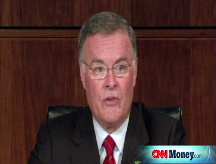Divorce - Bank of America style
Ken Lewis was happy as a bridegroom when he swooped in to buy Merrill Lynch. Now he has ditched John Thain and is struggling to make the deal work.
NEW YORK (FORTUNE) -- On Sept. 15 last year, Bank of America CEO Ken Lewis triumphantly unveiled his $50 billion deal to buy Merrill Lynch, an American icon. Lewis, 61, had coveted Merrill for years, and he planned nothing less than a cultural revolution. The steady, watch-the- nickels branch banker from Charlotte would impose commonsense discipline on the wounded bull, banishing the profligate practices he'd long reviled, especially inflated pay and the high-risk trading that had landed Merrill in so much trouble.
Standing shoulder to shoulder with Lewis at Bank of America's sleek New York City office tower that late-summer day was Merrill CEO John Thain, 53, who seemed to be the perfect partner for the transformation. In fact, Thain looked and acted like a younger version of Lewis. Both men were granite-jawed, sober-suited, sporting wire-rims, and exuding a formal, dignified manner. Although steeped in Wall Street's ways, Thain swore he was as keen on curbing its excesses as Lewis was, and claimed to be molding Merrill into just the kind of operation Lewis wanted, one that relied on stable brokerage and underwriting - and shunned risky trading.
Just four months later, Thain is gone, and it looks as if Wall Street is taming Ken Lewis rather than the other way around. Since the deal was announced, BofA's stock price has plummeted 80%, to around $7 a share, erasing $170 billion in market value for the two companies. By December the financial state of both Merrill and BofA had deteriorated so alarmingly that the federal government had to come up with a giant rescue package, comprising a $20 billion cash infusion and guarantees on nearly $100 billion of troubled assets, to salvage the combined companies.
This isn't just another story of a big deal gone bad fast. BofA (BAC, Fortune 500) touches far more customers than any other U.S. bank. It holds 10% of all retail deposits in its 6,100 branches, originates one in five of America's mortgages, and has 130 million credit cards in circulation. Merrill's 16,700 brokers watch over $1.8 trillion in investments for their more than five million clients. Lifting BofA and other big diversified banks, notably Citigroup and Wells Fargo, out of their hunkered-down crisis mode is essential to expanding credit and reviving the U.S. economy. And so far the BofA mess demonstrates the shortcomings of the government's efforts to stabilize the banking system. While Washington has committed billions of dollars to propping up the bank, BofA is still hobbled, and could end up needing an even bigger bailout - or even nationalization.
Why did the union Lewis lauded as the "deal of a lifetime" spin so quickly into disaster? To answer that question, we have to go back to December 2007, when the Merrill board named John Thain as CEO to replace Stanley O'Neal, who had been fired in October. A 24- year veteran of Goldman Sachs, Thain was viewed as a Wall Street wizard. In four years as chief of the New York Stock Exchange, where he replaced Richard Grasso, he had turned the antiquated Big Board into a fully electronic, worldwide platform through a series of shrewd mergers that created NYSE Euronext, enriching NYSE shareholders in the process.
At Merrill, Thain pledged to gradually sell off the CDOs and other toxic assets inherited from O'Neal and to reduce the company's dependence on proprietary trading. His first big move was a stunner. In late July, Thain sold $31 billion in CDOs to Lone Star, a Texas hedge fund, at a huge discount. Though Merrill took a large loss, the sale sent a welcome message to investors: Unlike other firms, Merrill was facing its future squarely, recognizing that the world had changed and bubble values wouldn't come close to returning. In an interview, Thain described it as a "huge move in reducing risky assets on our balance sheet."
But Thain showed little inclination to reduce Merrill's bloated pay and lifestyle. He famously spent $1.2 million decorating his office on the 32nd floor of the World Financial Center. Fortune has learned that Thain's expenditures made Merrill's procurement officers so nervous that they insisted that Thain sign off personally on the budget. Thain also handed out lavish packages to new hires. Peter Kraus, whom Thain lured from Goldman to head strategic planning, got a guarantee of around $25 million, which he received even though he left the company after three months. (At least Kraus used his own spectacular artwork and furniture to redecorate his office.) Thain was even more generous to Thomas Montag, installing him as head of sales and trading with a $39.4 million package.
***
After the big asset sale, Thain continued to unload the toxic paper he had inherited from the O'Neal regime, cutting the total from an estimated $135 billion when he arrived to $50 billion by the end of September. But despite his earlier words, he did little to rein in Merrill's proprietary trading operation, which took supposedly low-risk positions in currencies, commodities, and especially bonds, and had been a reliable profit center for years. That decision would come back to haunt him.
In September the credit crisis entered a new, more virulent phase. As Lehman Brothers slouched toward collapse, investors began fleeing all financial firms. On Saturday, Sept. 13, Greg Fleming, Merrill's president, prodded Thain to call Lewis, who had made serious overtures to Merrill twice in the past year. Thain, who came into the job determined to keep Merrill independent, recognized that the credit crisis could swamp the firm. After 24 hours of frenzied negotiations, Lewis and Thain struck a deal for BofA to pay $50 billion in stock, or $29 a share for Merrill. That was a 70% premium to Merrill's closing price on Friday. Still, you can see why Lewis thought he was getting a steal: He was buying Merrill for about one-third its value when he'd first approached O'Neal about a merger in September 2007. By the time the deal closed, the collapse in BofA's shares brought the final price down to $19.4 billion.
Merrill would prove to be no bargain. For the third quarter it posted a loss of $5 billion, which had been expected. But in the fourth quarter things got even uglier. On Dec. 8, the Merrill board gathered at the company's World Financial Center headquarters for its final meeting and heard a chilling report. Losses for October and November already stood at around $7 billion; that figure exceeded the projections for the entire fourth quarter. And the losses ballooned as December wore on, reaching a sickening $15.5 billion.
Despite the bleak numbers it heard on Dec. 8, the board went ahead and approved bonuses of around $4 billion for Merrill employees - a figure well below the maximum authorized by BofA. In late December the board shaved that number by 10%. Thain didn't get a bonus, but not for lack of trying. In the fall he had floated a request for a $40 million bonus to the board through his HR staff. By the Dec. 8 board meeting, Merrill's losses were so steep that the board, like most others on Wall Street, nixed bonuses for top executive officers while still rewarding investment bankers, traders, and other big producers.
***
What went so terribly wrong in the fourth quarter? The write-downs on the "legacy" leveraged loans and CDOs from the O'Neal era - around $7 billion after tax - were expected. The shock was the enormous losses on fixed-income trading, specifically the credit positions that were part of Merrill's proprietary trading book. (The information on Merrill's fourth-quarter losses comes from ex--Merrill board members and current and former executives, none of whom would speak on the record.) In the fourth quarter the U.S. suffered the worst credit meltdown in memory. The spread between Treasury yields and those on high-grade corporate bonds jumped to 3.4 points - two points is the usual margin - while the spread between junk bonds and Treasury yields soared to 19 points. Merrill's plain-vanilla portfolio of about $50 billion in corporate bonds was pummeled.
Merrill also had another $50 billion or so in "correlation trades." In a correlation trade, investors seek to profit from the spread between the interest on a bond and the cost of insuring that bond, usually via credit default swaps. Such trades typically produce a reliable stream of profits. But the credit crunch was so violent that the price of the bonds fell far more than the price of the swaps rose, as panicked investors, irrationally it would seem, dumped the swaps. Merrill also bought protection from the so-called monoline insurers, such as MBIA and Ambac. But when those insurers were downgraded by the rating agencies, the protection Merrill had paid for was less valuable, and Merrill had to add to its reserves to make up the difference. That alone saddled Merrill with $3.2 billion in fourth-quarter losses. Even with those details, mystery still shrouds the epic write-downs: It's not at all clear why more than half the losses occurred in December, when the credit markets were calmer than they were in October and November.
When Lewis saw Merrill's write-downs mounting, he wanted to get out of the deal. BofA also faced a disastrous fourth quarter as losses on consumer loans, from credit cards to home equity, kept cascading. Lewis feared that BofA no longer had enough capital to absorb a damaged Merrill. On Wednesday, Dec. 17, he flew to Washington to discuss his options. At 6 p.m., he sat down with Fed chairman Ben Bernanke and Treasury Secretary Hank Paulson in the cathedral-like Federal Reserve building, renowned for its echoing vastness. Lewis told Bernanke and Paulson that because Merrill's losses were so much worse than expected, BofA was in a position to invoke a "material adverse effect" clause from the merger contract to cancel the deal.
Bernanke and Paulson weren't swayed. They told Lewis that the Fed's legal staff had read the contract, and that under the law, BofA absolutely had to close the deal. They also said that a failure to buy Merrill would put the entire banking system at risk. They made it clear that renegotiating the price - a natural move in normal times - was not an option. The reason: It would take two months to issue new proxy statements and hold shareholder votes at both companies, while the fate of Merrill stayed in limbo. Bernanke and Paulson said they would provide a rescue package for BofA to ensure that it had adequate capital to complete the deal.
Technically the government did not have the authority to force Lewis to buy Merrill. But it hardly matters: In the current crisis bankers have little alternative but to do what Washington tells them. "The Fed and Treasury made it crystal clear," says one person familiar with the talks. "Our position is your position."
***
In the last weeks of 2008, Lewis was losing confidence in Thain. On December 20, Thain began a two-week vacation in Vail, Colo. Bank of America insiders say that Lewis was disturbed by Thain's seeming detachment. Allies of Thain's from the Merrill ranks say that no one from BofA called Thain to discuss the losses while he was in Vail. And when the merger closed on Jan. 1, Thain remained head of Merrill Lynch, now a subsidiary of BofA. But as word of the losses and bonuses became public, pressure on Lewis mounted. On Jan. 22, he flew to New York City and asked Thain to resign. The meeting took just five minutes, say Thain's allies, and Lewis's explanation was that the board blamed Thain for Merrill's losses.
There's no doubt that Thain bears a lot of the responsibility for Merrill's recent woes. (Thain would not comment for this story.) He oversaw trading directly for more than half his term at Merrill, until he hired Thomas Montag (who now runs sales and trading for the combined bank). "His excuse that all the risky trades were 'legacy positions' left over from his predecessors is absurd," says Janet Tavakoli of Tavakoli Structured Finance, a capital markets consulting firm. "He was CEO for a year, so he should have sold off those positions. They were his legacy positions!"
But Lewis, too, must shoulder a share of the blame. (Lewis would not comment.) He failed to recognize how perilous those positions were, and placed far too much confidence in Thain's assurances when the numbers told a different, dangerous story. It's also clear that BofA knew all about the size and scope of Merrill's risky assets. In October, BofA installed its chief accounting officer as Merrill's acting CFO. It had access to Merrill's daily profit-and-loss statements and all its trading positions. So far, though, there is no sign that the board has lost confidence in Lewis. At a late-January meeting, directors backed Lewis and declared that the issue of his status "is not expected to be reopened."
Regardless of who's sitting in the corner office, the Merrill deal is likely to weigh down BofA for years to come. Lewis is now fighting a two-front war. The Merrill deal has vastly increased BofA's exposure to risky assets. And with the economy in the grip of a severe recession, BofA is getting hit hard in its staple businesses: losses on home-equity loans and credit card balances are soaring. Write-offs on the entire consumer-loan portfolio, which totals $931 billion, have more than doubled over the past year, from 1.2% to 2.8%. And the bank is now bracing for a wave of defaults on small-business and commercial real estate loans.
The terms of the government's rescue apply even more pressure. Washington has provided BofA and Merrill with $49 billion in preferred stock; BofA also has another $31 billion in preferred shares outstanding. BofA must pay $5.4 billion in annual dividends on its preferred - money that comes out of earnings and is not tax-deductible. Analysts don't expect BofA to earn enough to cover the preferred dividends for the first two quarters of 2009, which means that the bank's capital would be reduced. If its capital shrinks, however, BofA will have even less ability to make loans, further impeding the economic recovery.
The Obama administration is now talking about a new approach: setting up a "bad bank" to buy toxic assets. It would purchase subprime mortgages and other damaged securities at prices high enough to help banks rebuild their capital. But to fully regain their health, the banks need to expand earnings enormously. So even with the toxic assets off its books, BofA would be dancing on a knife-edge: If the credit cycle doesn't get much worse, profits will jump, and it will be able to raise money in public markets. If mortgages and credit card and commercial loans continue to crater, BofA would probably become a ward of Uncle Sam. That would mean the nationalization of America's largest bank, and a very different ending to Ken Lewis's dream of bringing commonsense banking to Wall Street. ![]()
-
 The retail giant tops the Fortune 500 for the second year in a row. Who else made the list? More
The retail giant tops the Fortune 500 for the second year in a row. Who else made the list? More -
 This group of companies is all about social networking to connect with their customers. More
This group of companies is all about social networking to connect with their customers. More -
 The fight over the cholesterol medication is keeping a generic version from hitting the market. More
The fight over the cholesterol medication is keeping a generic version from hitting the market. More -
 Bin Laden may be dead, but the terrorist group he led doesn't need his money. More
Bin Laden may be dead, but the terrorist group he led doesn't need his money. More -
 U.S. real estate might be a mess, but in other parts of the world, home prices are jumping. More
U.S. real estate might be a mess, but in other parts of the world, home prices are jumping. More -
 Libya's output is a fraction of global production, but it's crucial to the nation's economy. More
Libya's output is a fraction of global production, but it's crucial to the nation's economy. More -
 Once rates start to rise, things could get ugly fast for our neighbors to the north. More
Once rates start to rise, things could get ugly fast for our neighbors to the north. More










